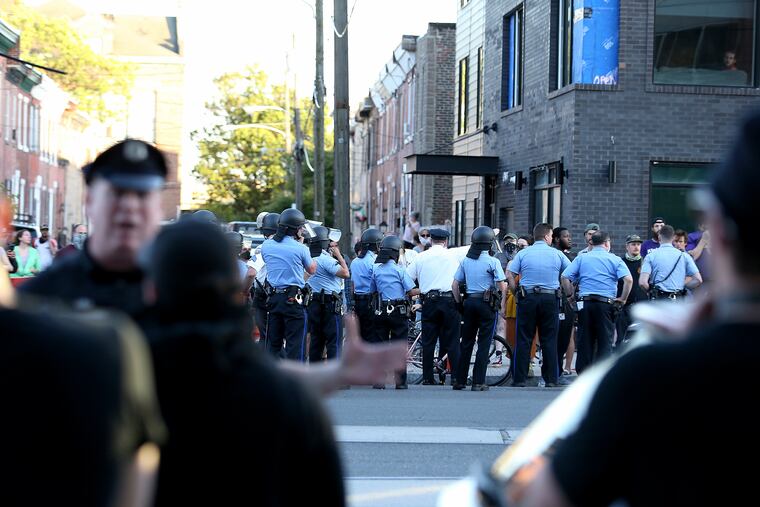Fishtown police must repair neighborhood relations after support of white men with weapons | Opinion
The Fishtown police must send a message to the neighborhood that they condemn racist policing and that they do not tolerate racism or vigilante justice.

On Monday night, a vigilante mob of white civilians took it upon themselves to “guard” the 26th District police station on Girard Avenue in Fishtown. They were armed with baseball bats, golf clubs, and the occasional hatchet. They claimed to be “protecting” local businesses from Antifa protesters who never materialized. As the night went on, the mob became increasingly belligerent toward pedestrians and passing cars. For hours, we watched the mob heckle people of color, peaceful protesters, and people wearing progressive T-shirts.
We’ve lived in Fishtown for five years and that was the most afraid we’ve ever felt in our neighborhood.
But most disturbing was that local police appeared to be giving the group their blessing. We watched police officers shake hands and chat amicably with men wielding bats. Notably absent was any organized police line to control the mob’s movement, like we’ve seen in other protests in the city. Instead, the police and mob stood next to each other in apparent solidarity. The 6 p.m. curfew came and went, and we saw no effort to disperse the crowd.
At the same time in Center City, peaceful protesters of George Floyd’s murder were met with lines of riot police and targeted with tear gas. The stark contrast should have us all asking: Why do our police feel more affiliated with white men holding weapons than black men holding signs?
» READ MORE: Here’s live coverage of what’s happening June 3
A central message in the countrywide protests is that policing is racially disproportionate. Black people are three times more likely to be killed by police than white people. One major contributor to the higher death rate is simply that black neighborhoods are policed more frequently, and as a consequence, black Americans are stopped more often by police. More interactions with the police mean more chances to die at their hands.
Police treat the same behaviors differently based on skin color and zip code. This is precisely what we saw Monday night. When a white man in Fishtown demonstrates threatening behavior, he is merely “protecting himself,” but when a black man demonstrates that same threatening behavior, he is a criminal threat.
On Tuesday night, we joined a group of peaceful anti-racist demonstrators in Fishtown. The crowd looked different from the homogenous group the previous evening; the protesters included women, people of color, and children. The police presence had increased tenfold from the night before, although there was not a single baseball bat to be seen in the crowd. It was disheartening to see this disproportionate response from police, but it comforted us to see our community unite in solidarity against the racism of the night before. Marching with fellow residents around our block was the safest we’ve ever felt in Fishtown. Neighbors stepped out on their stoops to cheer for the passing crowd and raised a fist or a homemade sign as we passed.
In the last decade, the Philadelphia Police Department has worked hard to evaluate its use of force policies and to implement meaningful protections against police violence, including requiring that officers exhaust all alternatives before shooting. What we witnessed on Monday demonstrates that there is still insidious racial bias in the way the Philadelphia police make decisions.
The Fishtown police must send a message to the neighborhood that they condemn racist policing and that they do not tolerate racism or vigilante justice. Yesterday, Mayor Jim Kenney spoke out against the Fishtown mob. We now need our local precinct to publicly echo that same condemnation. We also ask that Philadelphia police investigate the incident and commit to rigorous, long-term anti-bias training for its officers.
We appreciate everything our police officers do to protect our city. We know it’s not easy, and we can’t imagine having to make the choices the police have to make every day. One way to start the healing in our community is to build spaces for police and citizens to come together to share perspectives and experiences. Police precincts should lead monthly, ongoing small group discussions with local residents about racism. We all need empathy now more than ever. We challenge District 26 to lead this charge.
Andrew Knips and Kendall LaParo live in Fishtown.